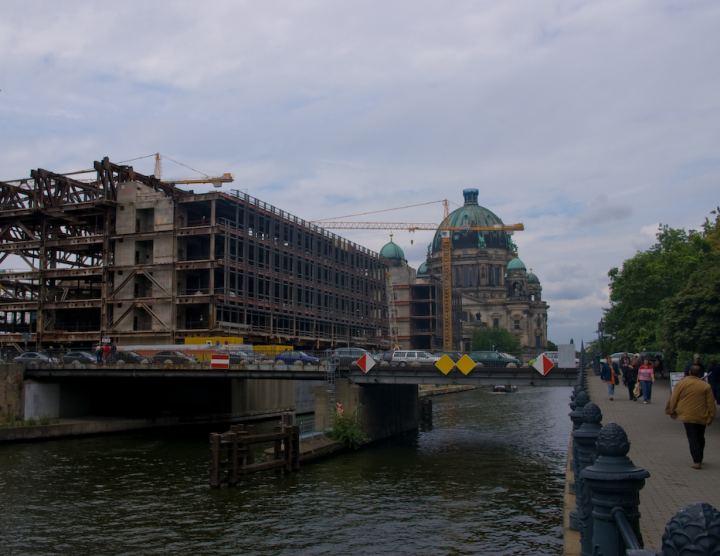
Schloss and Dom

In German, the first means castle, the second “dome” and often, by attribution, cathedral. In the center of Berlin, one’s right beside what used to be the other.
Here’s some context:
The Schloss is in the foreground and the Dom behind. In the old days, the Schloss was the Kaiser’s nerve centre; in WWII it took (like pretty well all of Berlin) severe bomb damage. The DDR government, which had little use for the Prussian monarchical heritage, deemed that it couldn’t be repaired, and put up the Palast der Republik; Lauren tells me she visited it at least once, pre-1989.
It was found to have severe asbestos contamination and is currently being taken down; “Dismantled, not demolished” say the billboards in German and English too. The process is visually dramatic.
You can’t go inside it any more, but you can go into the Dom; you have to pay, which rankles a bit. I love ecclesiastical architecture, largely as a consequence, I think, as a result of having been dragged through lots of it as a kid because my parents did too. So now I’m dragging mine.
Bazaars are good but cathedrals are nice too. Hard to photograph from the inside though, and capture a sense of scale.
Comment feed for ongoing:
From: John Cowan (Jul 14 2007, at 15:19)
(What, another oversized box? Will this never cease? I think I'm getting more oversized boxes than correct ones at this point.)
In Manhattan, demolition has been forbidden for many years; our obsolete buildings are also disassembled carefully, so as not to disturb nearby buildings or our creaky infrastructure. Right now, we are building rather than unbuilding for the most part, thanks to the current real-estate bubble; all over town we are losing parking lots and "taxpayers" (one- to two-story buildings put up to cover real-estate taxes until market conditions justify a full building).
[link]
From: Alan Little (Jul 15 2007, at 00:41)
<i>Schloss</i> is often wrongly translated into English as "castle", but really is something more like "palace" or the English term "stately home". It's used for things (roughly) 16th century onwards that were more for show than for fight. Serious mediaeval military architecture intended primarly to keep the Austrians/Turks/French/Slavs etc. out is a <i>Burg</i> - often translated into English as "fortress", although in reality a <i>Burg</i> is a castle and a <i>Schloss</i> isn't.
[link]